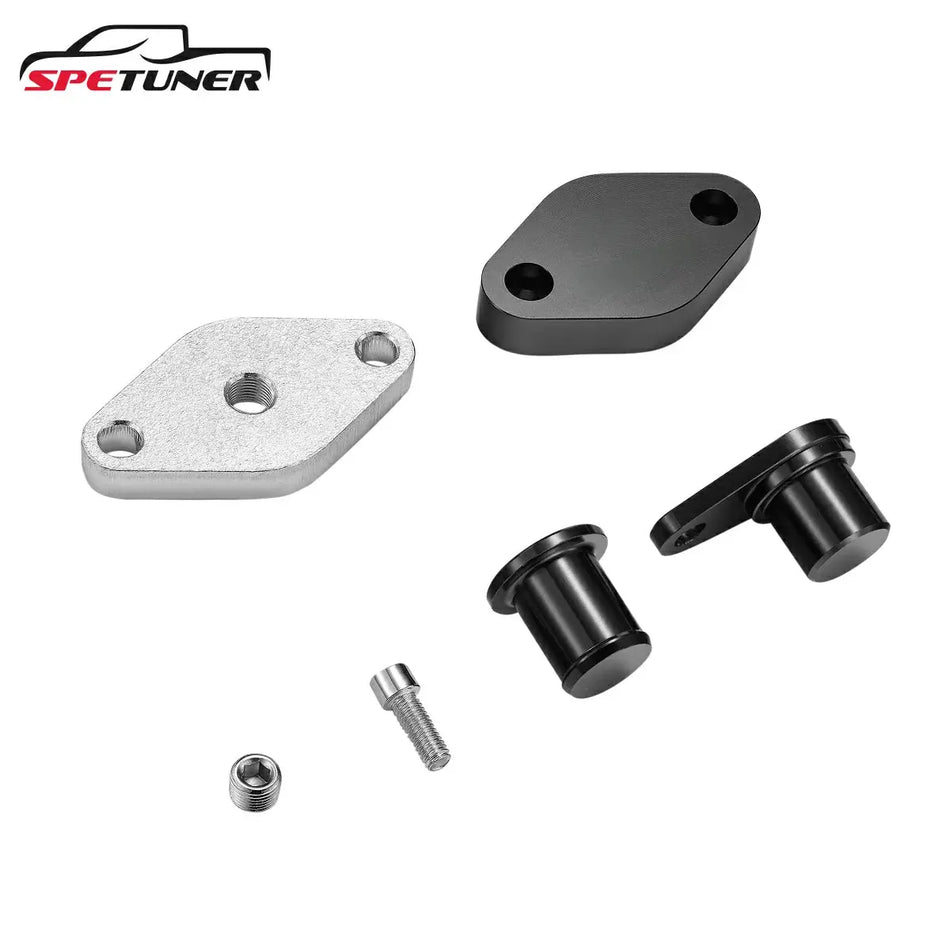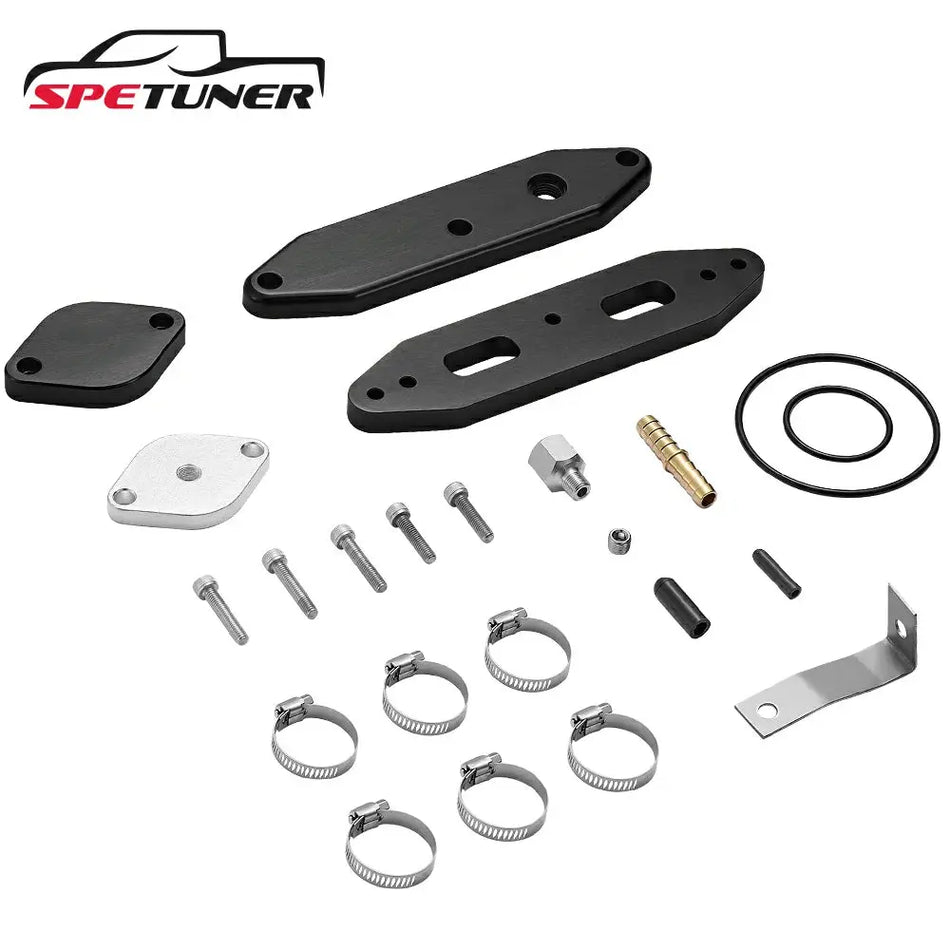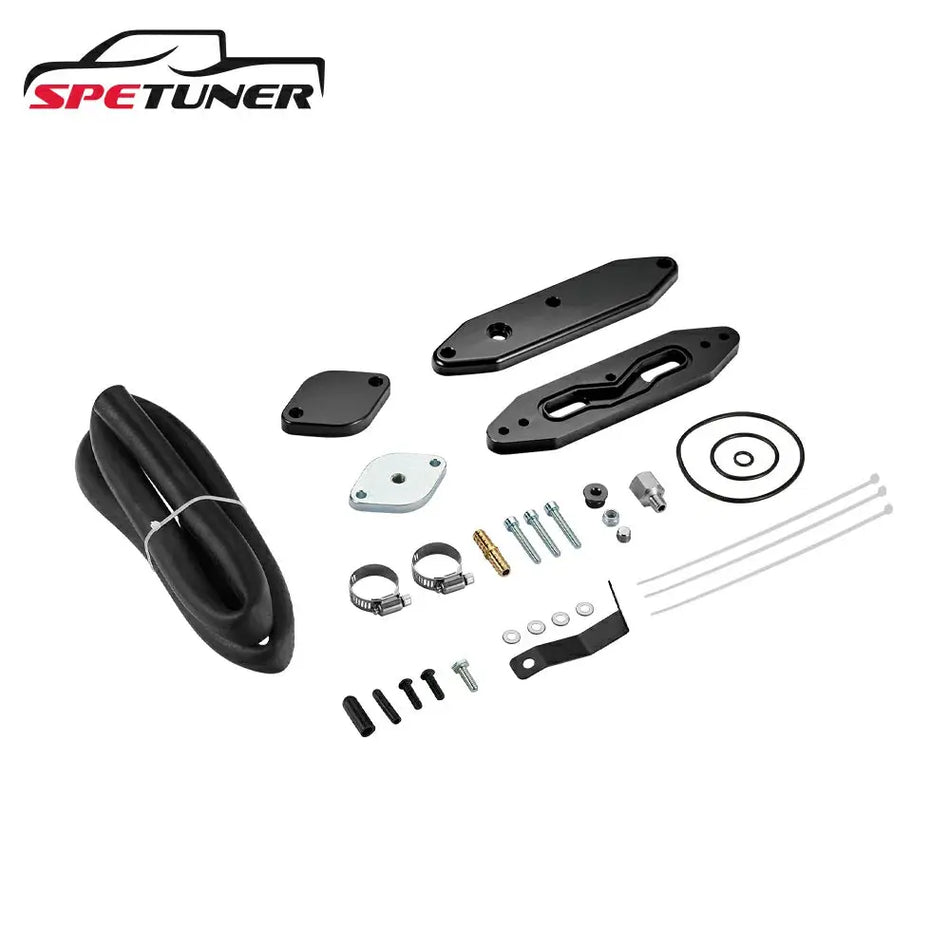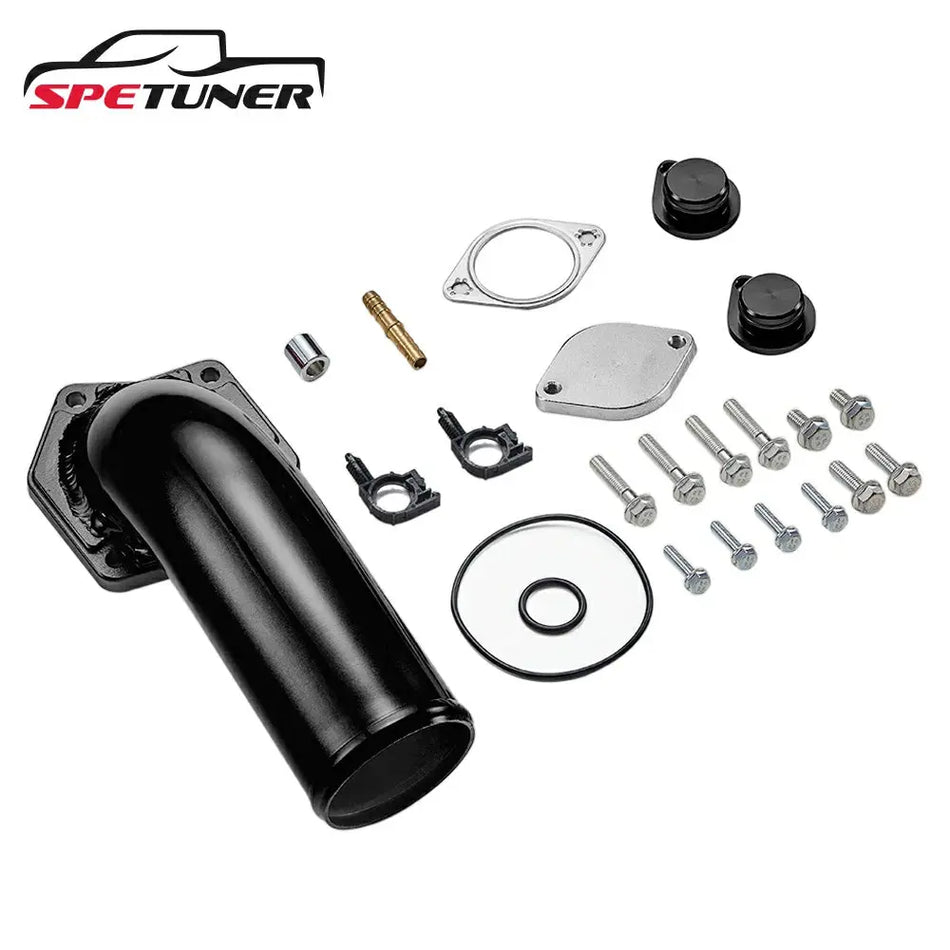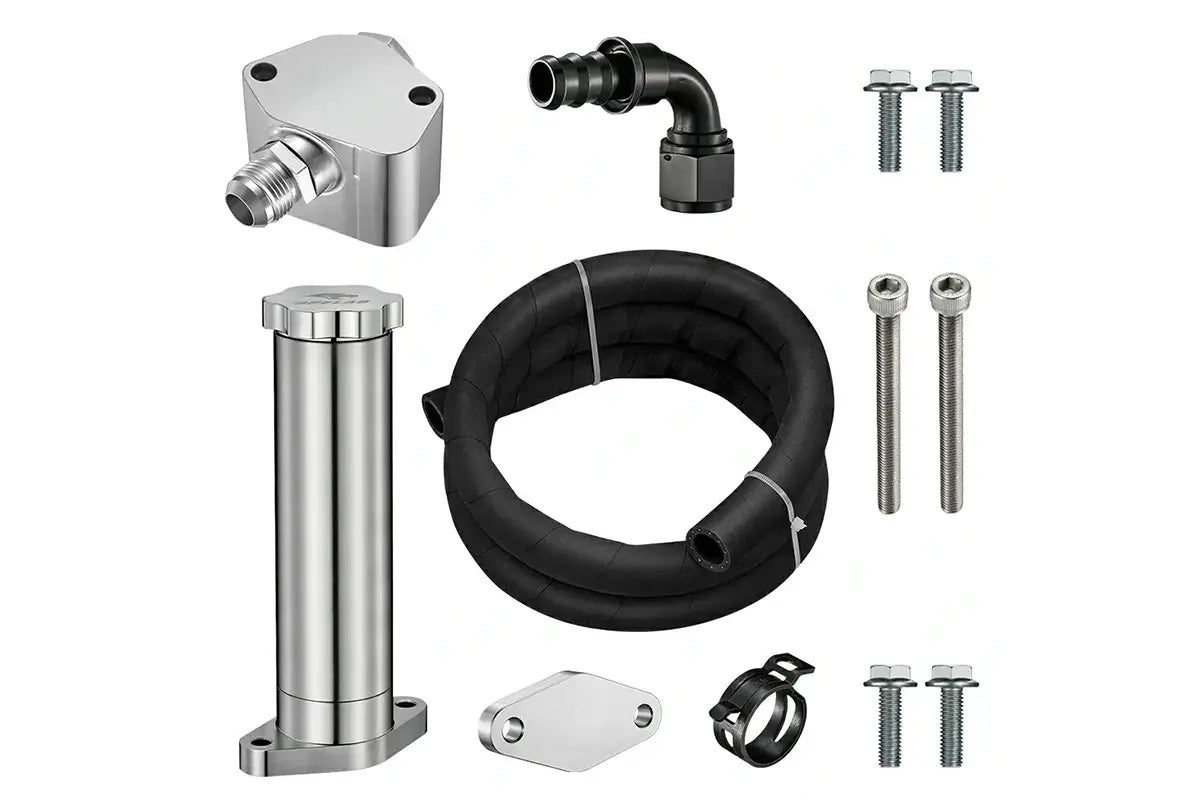What Is a Straight Pipe Exhaust System?
Definition and Key Characteristics
A straight pipe exhaust system is exactly what it sounds like—an exhaust setup that runs straight from the engine to the back of the vehicle without any restrictive components.
That means no mufflers, no resonators, no catalytic converters, and on diesel trucks—no DPF (Diesel Particulate Filter). Just raw, uninterrupted pipe.
This setup is all about one thing: unrestricted exhaust flow. The idea is to let the engine breathe out as freely as possible, reducing backpressure and improving exhaust velocity.
Straight-pipe systems are typically custom-fabricated or sold in delete kits for off-road or racing-use vehicles. You'll often find them on high-performance diesel trucks, track cars, and off-road builds where emissions compliance isn’t a concern.
Because it removes all the “quieting” and “filtering” elements, it’s not just louder—it’s brutally loud. Think deep growls, turbo whistle, and zero tone control. That’s part of the appeal for many enthusiasts.
How It Differs from a Standard Exhaust System
A factory exhaust system is composed of several components designed to reduce noise, control emissions, and maintain smooth and quiet operation. These components include the muffler, resonator, catalytic converter, and, for diesel trucks, components such as the DPF and SCR system.
In contrast, a straight pipe setup strips away all of that. No muffler means no sound dampening. No catalytic converter means no emission filtration. It’s just raw piping from the turbo (or headers) straight to the tailpipe.
Where a stock system prioritizes comfort and emissions compliance, a straight pipe focuses purely on performance and sound. That trade-off means you're giving up street legality and daily comfort—but gaining maximum airflow and a mean exhaust tone.
So in short:
-
Stock exhaust = clean, quiet, and compliant
-
Straight pipe = loud, aggressive, and built for power
Common Use Cases (Diesel Builds, Track Cars, Off-Road Vehicles)
Straight pipe exhaust systems aren’t for everyone—but in certain builds, they make perfect sense.
In the diesel performance world, straight piping is especially popular. Removing the DPF and installing a full 4" or 5" straight pipe can lower exhaust temperatures, enhance throttle response, and help the turbo spool up faster. It's a common mod for Cummins, Powerstroke, and Duramax trucks used in sled pulling, drag racing, or heavy off-road towing.
On the gasoline side, you’ll find straight pipes used in track cars and drift builds where performance and sound are prioritized over comfort or emissions compliance.
Off-road rigs also benefit from simpler, lighter exhaust systems. A straight pipe is easier to route and maintain in rugged environments—and if you're climbing rocks or ripping through mud, drone and noise are the least of your concerns.
In all cases, the key is this: straight piping is most appropriate when the vehicle is not subject to street-legal restrictions, or when performance takes precedence over everything else.

How Does a Straight Pipe Affect Performance?
Improved Exhaust Flow
One of the primary reasons people opt for a straight pipe is to eliminate restrictions. When you eliminate components like the muffler, catalytic converter, and DPF, you allow exhaust gases to exit more quickly and with less resistance.
This improves exhaust flow and reduces backpressure, which helps the engine operate more efficiently—especially under load or at high RPMs.
The result? Quicker turbo spool, faster throttle response, and better top-end power.
Throttle Response and Potential Horsepower Gains
In diesel applications, a straight pipe can significantly improve throttle feel—especially when paired with proper tuning. The turbo can spool quicker without backpressure holding it up, which translates into more immediate boost.
While horsepower gains vary depending on the engine, supporting mods, and tuning, it's not uncommon to see a 15–30 HP improvement just from the exhaust system alone on a tuned diesel truck.
For gas vehicles, the gains are smaller unless you're pairing it with other mods, such as headers or forced induction.
The Role of ECM Tuning After Deleting Emissions
Here’s the catch: deleting emissions components like the DPF or catalytic converter usually triggers check engine lights, limp mode, or even drivability issues—unless the ECM (Engine Control Module) is properly reprogrammed.
So, a straight pipe setup almost always requires a truck tuner to disable those codes and recalibrate fueling/timing to match the new exhaust flow.
Without proper tuning, you might end up with worse performance, not better.
Why Do People Install Straight Pipes?
Better Sound and Loudness
Let’s be honest—sound is one of the biggest reasons people go straight pipe.
Removing mufflers and resonators unleashes the raw exhaust tone. For diesel trucks, this means deep, aggressive rumble, loud turbo spool, and sometimes a barking exhaust crackle. For gas vehicles, you get a high-revving growl or scream, depending on the engine type.
If you want your vehicle to sound like it means business, straight piping definitely delivers.
Just be ready for it to be loud. Really loud.
Removing Flow Restrictions (DPF, Muffler, Resonators)
Stock exhaust systems are designed primarily for emissions compliance, rather than performance.
Parts like the DPF in diesel trucks or catalytic converters in gas cars restrict flow and increase backpressure. Mufflers and resonators also slow down the flow of air to dampen noise.
By taking all that out, you're giving the exhaust a direct route out of the system—no filters, no turns, no resistance. It’s the simplest path, and often the most efficient if you’ve got tuning to match.
Customization and Diesel Tuning Culture
Straight pipes aren’t just a mod—they’re a statement.
In the diesel community, running a straight pipe is almost a rite of passage. It shows you're serious about performance and not afraid to go all-in on your build.
Plus, there’s a social side to it: truck meets, sled pulls, YouTube builds, and dyno comps. Straight piping is part of the culture—just like lift kits, tuned ECMs, and rolling coal (legally, of course).
If you're building a truck or car to turn heads and make noise, a straight pipe is usually one of the first upgrades.
Is Straight Piping Legal?
US and Canada Regulations on Emissions & Noise
In most parts of the U.S. and Canada, straight piping a vehicle—especially one that was originally equipped with emissions equipment—is not legal for street use.
Why? Because removing components like the catalytic converter or DPF violates federal emissions laws under the Clean Air Act (in the U.S.) or Environment Canada regulations.
In many states and provinces, driving a straight-piped vehicle on public roads can lead to fines, failed inspections, or having your vehicle flagged by law enforcement.
Why Are Straight Pipes Illegal in Many States?
Straight pipes are loud. Like, wake-the-neighbors loud.
That kind of noise often exceeds local decibel limits and contributes to noise pollution, especially in residential or urban areas.
Additionally, removing emissions equipment increases pollutants such as NOx and soot—something regulators take seriously. That’s why straight piping is generally restricted to off-road, track, or farm use only.
Street Use vs. Off-Road or Race Use Only
Here's the key distinction:
If you’re building a truck for track days, off-road trails, or private property, straight piping is typically fine—as long as you're not registering or driving the vehicle on public roads.
But if you're daily driving it, or planning to pass inspection in a state like California, straight piping is a non-starter unless you're using a race-use-only vehicle exemption (and those are rare).
Always check your local laws before deleting emissions components or installing a straight pipe.
Pros and Cons of Straight Pipe Exhausts
Advantages
✅ Unrestricted Exhaust Flow
With no mufflers or emissions gear in the way, a straight pipe gives your engine the easiest path to expel exhaust gases. Less restriction means better breathing—and for turbocharged engines, faster spool times.
✅ Performance Potential
Paired with the right tune, straight piping can unlock horsepower and torque that would otherwise be choked off by restrictive components. Especially noticeable on tuned diesel trucks and turbo builds.
✅ Aggressive Sound
There’s no denying it—straight pipes sound raw, loud, and unapologetically mechanical. For many enthusiasts, that’s part of the fun. It announces your build before you even pull into the lot.
✅ Weight Savings
All those stock components (resonators, mufflers, filters) add weight. Removing them simplifies the system and reduces some mass—an underrated bonus for performance builds.
Disadvantages
❌ Loud Cabin Drone
That same aggressive tone can become a headache on long drives. Without a muffler or resonator to smooth out the sound, interior drone is common—especially at highway speeds.
❌ Legal Issues
Straight pipes are illegal for street use in most regions. Driving one daily can mean failed inspections, tickets, or worse. Always check your local laws before making the swap.
❌ Environmental Impact
Removing emissions equipment increases harmful pollutants. Straight-piped diesel trucks, in particular, can produce heavy soot and smoke without DPF or SCR systems in place.
❌ Check Engine Lights & Tuning Needs
If you delete parts like the DPF or catalytic converter without proper ECM tuning, your truck or car will likely throw a CEL (check engine light), enter limp mode, or run poorly.
Straight Pipe vs. Muffler Delete vs. Cat-Back Exhaust
What’s the Difference?
These three exhaust setups are often confused, but they differ significantly in terms of components, legality, and sound.
-
A straight pipe removes everything from the catalytic converter or turbo back. That includes the DPF (on diesels), muffler, resonator, and any filters. It’s a full send—pure performance, maximum sound, zero filtration.
-
A muffler delete only removes the muffler, leaving the rest of the emissions and sound management components intact. It’s a mild, street-friendlier option for more noise without full deletion.
-
A cat-back system replaces everything after the catalytic converter. It typically includes a performance muffler and piping but leaves emissions gear untouched. These are often legal and still sound much better than stock.
Which Option Is Best for Your Goals?
-
Want something legal and daily-drivable? Go with a cat-back.
-
Want more sound but without going too wild? Try a muffler delete.
-
Want all-out performance and sound, and don’t care about emissions compliance? Then the straight pipe is your move—just be ready for the consequences.
Cost, Sound, and Performance Comparison
| System Type | Cost | Sound Level | Emissions Legal | Performance Gain |
|---|---|---|---|---|
| Straight Pipe | Low–Mid | 🔊🔊🔊🔊🔊 | ❌ | 🔥🔥🔥🔥🔥 |
| Muffler Delete | Low | 🔊🔊🔊 | ✅ (in some areas) | 🔥🔥 |
| Cat-Back System | Mid–High | 🔊🔊🔊 | ✅ | 🔥🔥🔥 |
Each system serves a different purpose—pick the one that fits your build, budget, and local laws.
Should You Straight Pipe Your Diesel Truck?
Straight Pipe with DPF Delete
For diesel owners, straight piping often goes hand-in-hand with a DPF delete. Removing the DPF and running a full 4" or 5" straight pipe dramatically increases exhaust flow. That means lower EGTs (exhaust gas temps), quicker turbo spool, and better fuel economy—especially when towing or running performance tunes.
But this kind of setup is only legal for off-road or race-use trucks. You’ll need a compatible tuner to reprogram the ECM and prevent warning lights or drivability issues.
Common Use with Powerstroke, Cummins, and Duramax
Straight pipes are especially common in:
-
6.7L Powerstroke builds using turbo-back kits for max flow
-
6.7L Cummins trucks, where a straight pipe often replaces the entire factory exhaust from the turbo
-
L5P Duramax platforms, frequently paired with custom tuning and EGR delete for full performance setups
These setups are popular for sled pulls, drag races, or dedicated off-road rigs that need high-flow exhaust with no restrictions.
Sound and Performance Benefits for Tuned Diesel Builds
Straight piping a tuned diesel truck gives you that signature turbo whistle, deep exhaust rumble, and sharp bark under throttle. It’s more than just noise—it’s feedback.
With proper tuning, straight pipe exhaust systems can free up 20–50 horsepower, improve throttle response, and reduce regen cycles that otherwise bog down performance.
Just keep in mind: the truck will be louder, more aggressive, and not street legal in most regions. This is a build choice that makes sense when you're serious about diesel performance—not daily commuting.
Final Thoughts: When Does Straight Piping Make Sense?
If You're Building a Race or Off-Road Truck
Straight piping makes the most sense when you’re building a non-street vehicle—something for the track, the trail, or competition use. If your truck lives on private land, farm property, or the drag strip, then performance and sound take priority over emissions compliance.
In these cases, removing every flow restriction in the exhaust system gives you maximum performance and minimal maintenance.
When Sound and Flow Matter Most
If you're chasing sound—that raw, unmuffled growl and screaming turbo whistle—straight pipe is hard to beat. Same goes if you're pushing your engine with big tunes, heavy towing, or high-boost applications where exhaust backpressure can become a performance bottleneck.
Just know what you're signing up for: louder cabin, more attention, and a setup that’s far from street-legal.
Always Consider Tuning and Legal Risks
Before installing a straight pipe, ask yourself two things:
-
Is this truck going on public roads?
-
Am I ready to tune the ECM properly?
If the answer to #1 is yes, don't do it—go with a high-flow legal alternative like a performance muffler or cat-back system. If the answer to #2 is no, you could risk engine trouble or permanent codes.
But if your build is tuned, off-road only, and built to be loud and proud—a straight pipe could be exactly what you're looking for.
FAQs
Q1: What is a straight pipe exhaust?
A: A straight pipe exhaust system is an exhaust setup with no muffler, catalytic converter, resonator, or DPF. It’s a direct, unrestricted pipe from the engine to the tailpipe, designed for maximum airflow and sound.
Q2: Why do people straight pipe their cars or trucks?
A: Most people do it for performance gains, louder exhaust sound, or to eliminate restrictive emissions components. It's especially common in diesel performance and race builds.
Q3: Is a straight pipe exhaust legal for street use?
A: In most places, no. Straight piping removes emissions equipment, which makes it illegal on public roads under EPA or local regulations. It’s typically allowed for off-road or race-only vehicles.
Q4: Does a straight pipe improve performance?
A: Yes, it can improve throttle response, reduce backpressure, and help turbos spool faster—especially when combined with proper ECM tuning. Gains are more noticeable on turbocharged and diesel engines.
Q5: Does a straight pipe make your vehicle louder?
A: Absolutely. Without mufflers or resonators, a straight pipe significantly increases exhaust noise. Expect a deep, aggressive tone, and noticeable cabin drone—especially at highway speeds.
Q6: What’s the difference between a straight pipe and a muffler delete?
A: A muffler delete removes only the muffler, while a straight pipe eliminates the entire exhaust restriction system—muffler, cat, resonator, and DPF (on diesels). Straight pipes are louder and less street-legal.
Q7: Can you pass inspection with a straight pipe?
A: No. Most states and provinces will fail vehicles without proper emissions components. You’ll likely trigger check engine lights and fail noise or smog tests.
Q8: Do you need a tune after straight piping?
A: Yes, especially on modern diesel or gas engines with emissions systems. Without a tune, the engine may run poorly, throw error codes, or go into limp mode.
Q9: Does straight piping affect fuel economy?
A: It can. Some drivers report slight gains due to improved airflow, but others see no change or even a drop—especially without tuning. Results vary based on build and driving style.
Q10: Is straight piping worth it?
A: If you're building an off-road or race vehicle, it can be a great performance mod. But for daily driving, the noise, legality issues, and tuning requirements make it less practical.

